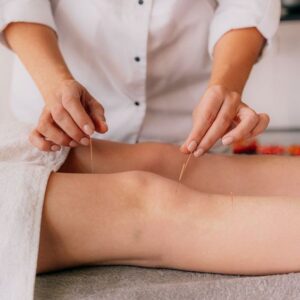
Whether you’re pounding the pavement for marathons or hitting the trail for a leisurely jog, the runner’s high is a pursuit that keeps millions of enthusiasts pushing their limits. However, with miles and intensity comes the risk of running-related injuries, often a showstopper in the otherwise invigorating activity. Conventional treatments include rest, ice, compression, and elevation (RICE) alongside physical therapy and medication. But here’s a natural therapy that’s been stood the test of time for millennia – acupuncture. In this comprehensive guide, we’ll explore the efficacy of acupuncture in addressing various running injuries and providing holistic recovery for runners.
Understanding Acupuncture in Context
The foundation of acupuncture lies in traditional Chinese medicine, where it is believed that the human body is governed by a life force called “qi”, which flows through meridians. Imbalances in these energies are thought to result in ailments and pain. Acupuncture involves inserting thin needles into specific points in the body to correct these imbalances, promoting the body’s natural healing abilities.
Western interpretations also back the efficacy of acupuncture for pain relief, suggesting that the needles provoke the nervous system, releasing chemicals that can dull or diminish pain or can affect the body’s internal regulation related to various physiological processes.
Tailoring Acupuncture for Running Injuries
The diverse landscape that runners traverse is often a minefield of stress points, from the pounding on common running paths to the uneven surfaces of nature trails. Acupuncture can be tailored to each injury and its unique pain points, offering customization that many find lacking in traditional treatments. Here’s how it adapts to common running injuries:
Plantar Fasciitis
The Focus: Alleviating heel pain and promoting the recovery of the connective tissue on the sole of the foot.
The Treatment: Acupuncture can be utilized to relieve inflammation and stimulate blood flow in the affected area, often leading to reduced pain and quicker healing.
Shin Splints
The Focus: Addressing the pain along the tibia, typically due to stress on the shinbone and the tissues attaching muscles to the bone.
The Treatment: Acupuncture can target the points related to stress and muscular tension to reduce discomfort and enhance recovery.
IT Band Syndrome
The Focus: Releasing tightness and pain in the iliotibial band, a tendon that runs down the outside of the thigh, which can result from overuse.
The Treatment: By targeting muscles and trigger points related to the IT band, acupuncture can help in relaxing the area and breaking the cycle of inflammation and pain.
Runner’s Knee
The Focus: Alleviating pain that originates from the kneecap, often as a result of overuse or maltracking of the knee joint.
The Treatment: Acupuncture can work to balance the muscles surrounding the knee, reducing tension and pain. Focusing on the lower back and hip points can also address structural imbalances influencing runner’s knee.
Combining Acupuncture with Modern Medicine
Acupuncture, when woven into an integrated treatment plan, can augment the effectiveness of traditional medicine. Combining acupuncture with physical therapy, for example, leverages the strengths of each discipline to provide a multifaceted approach to recovery.
How It Complements PT
Physical therapy aims to restore movement and function, often starting with stretches to improve flexibility and strength exercises to enhance support. Acupuncture can be neatly inserted into this routine to assuage pain, promoting compliance and faster rehabilitation.
Pairing with Medication
While medication is effective for mitigating pain, it typically carries side effects and the risk of dependency. Acupuncture offers a drug-free alternative that can be just as effective in some cases, without the risk of side effects or the need for ongoing medication.
Surgery vs. Acupuncture
For injuries that require surgical interventions, acupuncture may still play a role, either in preparation for surgery to reduce stress and promote relaxation or post-operatively to manage pain and support recovery.
The Acupuncture Experience for Runners
For those new to acupuncture, the prospect of receiving needles can be daunting. However, runners are often exposed to much more daunting challenges, and the potential benefits can make the experience worthwhile. Here’s what runners can expect when they seek acupuncture:
The First Visit
A typical initial visit involves a comprehensive consultation where the acupuncturist will gather information about the patient’s health history, pain points, and running habits. This is followed by the insertion of the needles, which is generally painless and can lead to various sensations, such as tingling or heaviness around the needle site – often a sign that “qi” is being influenced.
Frequency of Sessions
The frequency of sessions can vary depending on the injury’s severity and the individual’s response to treatment. Acupuncturists usually recommend a series of treatments to start, often weekly, with the frequency decreasing as the patient experiences relief.
Maintenance Sessions
Even after the pain has subsided, periodic visits can help maintain balance and ward off future injuries by addressing muscular imbalances and tension points.
The Science Behind Acupuncture for Runners
While empirical evidence and anecdotal reports strongly support the efficacy of acupuncture, modern research is also beginning to shed light on the physiological mechanisms supporting its use for runners:
Easing Muscle Tension
Studies have found that acupuncture can reduce myofascial trigger point activity, which is essential for runners aiming to maintain suppleness and prevent injuries.
Boosting Performance
Certain studies suggest acupuncture may enhance athletic performance by improving muscle strength, reducing recovery times, and lessening the perception of exertion.
Psychological Impact
The relaxation response induced by acupuncture can aid in stress reduction, promoting mental wellness and performance gains for athletes who often deal with the mental challenges of long-distance running.
Incorporating Acupuncture into Running Regimens
The newfound appreciation for holistic health approaches among athletes has driven the integration of acupuncture into routine regimens for runners. Mobile services and dedicated clinics are making it more accessible, and some professional athletes even travel with their acupuncturist.
Self-Care Techniques
Runners can incorporate acupuncture-like principles at home by utilizing techniques such as acupressure, using foam rollers, and maintaining a stretching and strengthening regimen.
Finding a Qualified Practitioner
The qualification and experience of the acupuncturist are paramount. Seeking referrals, understanding their background, and ensuring they are licensed can make a difference in the quality of the experience and its outcomes.
Budgeting for Acupuncture
While acupuncture is often an out-of-pocket expense, some insurance plans cover it. Alternatively, budgeting for acupuncture as part of the overall running expenses can underscore its importance in the maintenance and prosperity of a running career.
Conclusion
For runners, the road to recovery from injuries can be as challenging as the miles they clock. Acupuncture stands as a beacon of hope, offering a natural and personalized approach to accompany the runner’s highs and lows. Understanding its potential and weaving it into a comprehensive recovery plan can lead to quicker rehabilitation and possibly a stronger, more balanced stride to carry you forward into your next running adventure.
Acupuncture for running-related injuries is not a sprint; it’s a marathon, where consistency and a gradual approach often lead to the finish line of healing. With the surge in popularity and acceptance, integrating acupuncture into your recovery toolkit could be the step that sets you apart, not merely for the immediate relief it offers but for the enduring effects it can have on your running health.
In the race against running injuries, acupuncture offers runners a chance to pace themselves and find a balance that aligns mind, body, and spirit – a trinity as essential for recovery as it is for the running itself.


Follow Us